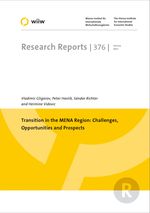Transition in the MENA Region: Challenges, Opportunities and Prospects
Vladimir Gligorov, Peter Havlik, Sandor Richter and Hermine Vidovic
wiiw Research Report No. 376, January 2012
68 pages including 16 Tables and 10 Figures
This paper discusses the transition agenda and provides the key economic characteristics of selected Middle East and North Africa countries (MENA) in comparison with selected Central, East and Southeast European countries (CESEE). We intend to identify some regularities in transition processes and to draw policy lessons for MENA countries. Among the key challenges facing the MENA region are job creation, fighting corruption, public sector reforms and trade diversification; the way towards a functioning market economy should not necessarily be as long and controversial as in the CESEE. MENA countries had been implementing market-oriented reforms for more than a decade. Together with free trade agreements concluded with the EU, these reforms have contributed to an increase of FDI inflows. Still, MENA countries have been lagging behind in terms of export performance, competitiveness and restructuring. Numerous impediments to trade and FDI in the MENA region need to be overcome, yet the transition will not require a radical overhaul of the existing system. The sine qua non condition is to achieve high per capita GDP growth. There is no guarantee for success – as illustrated by the experience of CESEE. Moreover, the current global crisis makes policy implementation not easier. If anything, future scenarios must reckon with a slow process of improvements and many backlashes. Transitions and sustainable reforms need to be anchored in a supportive international environment. In the case of many CESEE countries, the EU provided such an anchor. In the case of MENA, such a strong anchor is missing. A newly designed international involvement and especially the strengthened role of the EU will play a crucial role. A comprehensive EU-MENA trade agreement, possibly with an intra-MENA (and Turkey) Customs Union arrangement, would be beneficial to both MENA and the EU.
Keywords: transition, integration, foreign trade, FDI, labour market
JEL classification: E24, F13, F53, O2, O43, O57, P52
Countries covered: Albania, Algeria, Armenia, Azerbaijan, Bosnia and Herzegovina, CESEE, CIS, Egypt, Georgia, Kosovo, Libya, North Macedonia, Middle East and North Africa, Moldova, Montenegro, Russia, SEE, Serbia, Ukraine, Jordan, Lebanon, Morocco, Palestine Territories, Syria, Tunisia
Research Areas: Macroeconomic Analysis and Policy, Labour, Migration and Income Distribution, International Trade, Competitiveness and FDI
